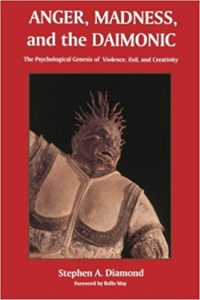 It is a bit intimidating to write a review of Stephen Diamond’s book. Rarely in my life have I read about book as packed with content as this volume. The 312 pages of this book read like 500-600 pages of text. While the thickness of ideas in this book make it a slow read, Diamond is still able to write in a manner that makes the book highly readable and easy to understand.
It is a bit intimidating to write a review of Stephen Diamond’s book. Rarely in my life have I read about book as packed with content as this volume. The 312 pages of this book read like 500-600 pages of text. While the thickness of ideas in this book make it a slow read, Diamond is still able to write in a manner that makes the book highly readable and easy to understand.
Diamond redeems anger in much the same way that Rollo May redeemed anxiety. Throughout the book he returns to the idea that what turns anger into evil, mental illness, and other destructive entities is not the presence of anger, but rather its denial, suppression, repression, and containment. What is needed is a healthy, creative expression and acceptance of anger. While this central thesis of the book seems simple enough, Diamond demonstrates why it is not so easy to redeem anger, especially in the context of an American society which abhors it. But it is this very dread of anger which has led to anger becoming a national epidemic!
Rollo May, in delineating the basic motivational theory of existential psychology, placed the idea of the daimonic at the center in much the way the the libido and the id were central features of Freud’s motivational system. Diamond makes several attempts at defining this elusive term. In his first attempt, he quotes Rollo May (1969) stating the daimonic “is any natural function which has the power to take over the whole person” (p. 65). This affirms the naturalness, the innateness, of the daimonic. The daimon is something very human and to be human is to have a daimon.
But what are these natural functions May and Diamond talk about? The elusiveness of this question is one of the strengths of this theory. Initially, Freud’s theory was almost exclusively based on sexuality (interpreted literally and symbolically) and our sex drive or life instinct. Later, Freud expanded his theory to include a death instinct. This allowed psychoanalysis to become much more inclusive, but it still remained a rather closed, fixed, and narrow system. In moving to the daimonic as the basic motivational component, both the life instinct (sex) and the death instinct were subsumed as part of the daimonic, but not the entirety of it. The daimonic is a mixture of instinctual (biological), experiential (personal history, emotions), and collective (cultural, societal, familial) influences. An individual can become focused on one aspect of the daimonic or experience it more broadly. In the Victorian era, when Freud was developing his theory of psychoanalysis, it was a societal phenomenon to repress and fixate on sexuality. Freud’s theory was a logical and accurate analysis of this phenomenon and it was not until later in his career that he began to realize this focus was only one aspect of the daimonic (though Freud was not drawn to using this word). Later, Becker (1973) will argue that death has become a new culturally repressed and fixated phenomenon. May will focus on the fixation on anxiety, but also broaden the awareness of the daimonic to include anger and many other emotions. Now, Diamond, argues that anger is becoming the new cultural fixation. As these fixations usually become repressed, they find their expression in mental illness and other societal ills.
The brilliance of Rollo May’s reintroduction of the daimon may well have gone largely unrecognized had it not been for Diamond. While Jung and the Jungians retained a similar idea with the shadow, this term was still much more narrow than the daimonic, as Diamond illustrates. I don’t think that this important reintroduction can be underestimated, especially given the current state of the field of psychotherapy. The Daimonic, as a broad, integrated motivational system, allows existential depth psychotherapy to become an ideal foundation for an integrated depth psychotherapy. I do not believe any other approach to depth psychotherapy retains such a flexible, inclusive structure.
Building on the theory of the daimonic, Diamond is able to provide a penetrating analysis of demonology and evil. These are difficult and controversial topics, especially in a time when America is experiencing a paradoxical increase in secularism and, at the same time, a rise in fundamentalism. Diamond’s critique of demonology and reinterpretation of this phenomenon as “daimonic possession” is as good of a critique of demon possession as exists.
Diamond also tackles the difficult issue of mental illness in an existential depth psychology framework. While many within the depth psychology traditions are skeptical of diagnosis, Diamond presents a good argument for diagnosis combined with a reinterpretation of the foundational theory of categorizing mental illness. In many ways, Diamond redeems diagnosis for depth psychotherapy for those who choose to diagnose. An important part of this redemption is Diamond’s claim that the etiology of most mental disorders stems from the psyche, not the individual’s biology. Or at least not solely in their biological makeup.
For people interested in existential theory and/or depth psychotherapy, few books are a more important read. Anger, Madness, and the Daimonic is an excellent introduction to the breadth and depth of existential theory.
Added November 2004; never been updated.
